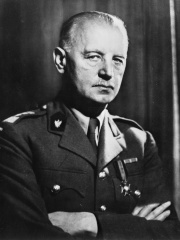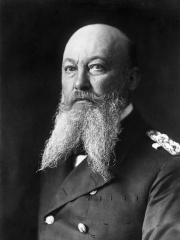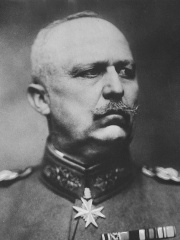
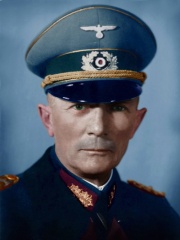
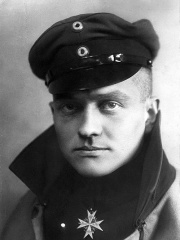
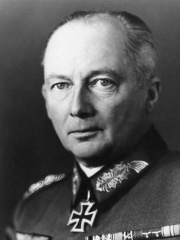
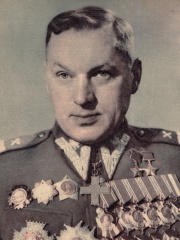
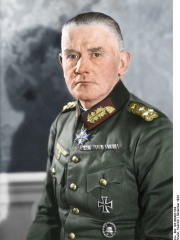
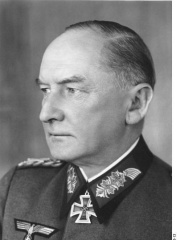
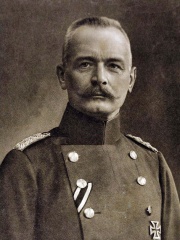
The Most Famous
MILITARY PERSONNELS from Poland
This page contains a list of the greatest Polish Military Personnels. The pantheon dataset contains 2,058 Military Personnels, 81 of which were born in Poland. This makes Poland the birth place of the 7th most number of Military Personnels behind United Kingdom, and Japan.
Top 10
The following people are considered by Pantheon to be the top 10 most legendary Polish Military Personnels of all time. This list of famous Polish Military Personnels is sorted by HPI (Historical Popularity Index), a metric that aggregates information on a biography's online popularity. Visit the rankings page to view the entire list of Polish Military Personnels.

1. Erich Ludendorff (1865 - 1937)
With an HPI of 77.47, Erich Ludendorff is the most famous Polish Military Personnel. His biography has been translated into 60 different languages on wikipedia.
Erich Friedrich Wilhelm Ludendorff (German: [ˈeːʁɪç ˈfʁiːdʁɪç ˈvɪlhɛlm ˈluːdn̩dɔʁf] ; 9 April 1865 – 20 December 1937) was a German general and politician. He achieved fame during World War I (1914–1918) for his central role in the German victories at Liège and Tannenberg in 1914. After his appointment as First Quartermaster General of the German General Staff in 1916, Ludendorff became Germany's chief policymaker in a de facto military dictatorship until the country's defeat in 1918. Later during the years of the Weimar Republic, he took part in the failed 1920 Kapp Putsch and Adolf Hitler's 1923 Beer Hall Putsch, thereby contributing significantly to the Nazis' rise to power. Ludendorff came from a non-noble family in Kruszewnia in the Prussian Province of Posen. Upon completing his education as a cadet, he was commissioned a junior officer in 1885. In 1893, he was admitted to the prestigious German War Academy, and only a year later was recommended by its commandant to the General Staff Corps. By 1904, he had rapidly risen in rank to become a member of the Army's Great General Staff, where he oversaw the development of the Schlieffen Plan. Despite being removed from the Great General Staff for meddling in politics, Ludendorff restored his standing in the army through his success as a commander in World War I. In August 1914, he led the successful German assault on Liège, earning him the Pour le Mérite. On the Eastern Front under the command of General Paul von Hindenburg, Ludendorff was instrumental in inflicting a series of crushing defeats against the Russians, notably at Tannenberg and the Masurian Lakes. By the end of August 1916, General Ludendorff successfully lobbied for Hindenburg's appointment as head of the Supreme Army Command and his own promotion to the rank of First Quartermaster General. Once he and Hindenburg established a military dictatorship in all but name, Ludendorff directed Germany's entire military strategy and war effort for the rest of the conflict. In this capacity, he secured Russia's defeat on the Eastern Front and launched a new wave of offensives on the Western Front resulting in advances not seen since the war's outbreak. However, by late 1918, all improvements in Germany's fortunes were reversed after a string of defeats culminating in the Allies' Hundred Days Offensive. Faced with the war effort's collapse and a growing popular revolution, Kaiser Wilhelm II forced Ludendorff to resign. After the war, Ludendorff became a prominent nationalist leader and a promoter of the stab-in-the-back myth, which posited that Germany's defeat and the settlement reached at Versailles were the result of a treasonous conspiracy by Marxists, Freemasons and Jews. He also took part in the failed 1920 Kapp Putsch and 1923 Beer Hall Putsch before unsuccessfully standing in the 1925 election for president. Thereafter, he retired from politics and devoted his final years to the study of military theory. His most famous work in this field was The Total War, where he argued that a nation's entire physical and moral resources should remain forever poised for mobilization because peace was merely an interval in a never-ending chain of wars. Following his death from liver cancer in Munich in 1937, Ludendorff was given—against his explicit wishes—a state funeral organized and attended by Hitler.

2. Fedor von Bock (1880 - 1945)
With an HPI of 77.17, Fedor von Bock is the 2nd most famous Polish Military Personnel. His biography has been translated into 53 different languages.
Moritz Albrecht Franz Friedrich Fedor von Bock (3 December 1880 – 4 May 1945) was a German Generalfeldmarschall (Field Marshal) who served in the German Army during the Second World War. Bock served as the commander of Army Group North during the Invasion of Poland in 1939, of Army Group B during the Invasion of France in 1940, of Army Group Center during Operation Barbarossa in 1941, and of Army Group South on the Eastern Front in 1942. Bock was a staff officer of the Imperial German Army during World War I and rose through the ranks of the post-war Reichswehr during the Weimar Republic. Bock was given his first command post in 1935, playing a key role in the Anschluss, the annexation of the Sudetenland, the invasion of Poland, and the invasion of France for which he was promoted to Generalfeldmarschall. Bock was successful during Operation Barbarossa and commanded Operation Typhoon, the German attempt to capture Moscow during the autumn and winter of 1941, which was slowed by the rasputitsa and stiff Soviet resistance around Mozhaisk. Bock was a monarchist neutral to the Nazi regime and not heavily involved in politics, but he did not sympathize with plots to overthrow Hitler. Bock was outspoken in his disagreement with Hitler and the Army High Command's strategy on the Eastern Front, a privilege extended to him only because he had been successful in battle. After the failure of Operation Typhoon and the German retreat from the Red Army, Bock was relieved of his command by Hitler in July 1942 forcing him into retirement for the rest of the war. Bock was killed by a strafing Royal New Zealand Air Force plane on 4 May 1945 while travelling by car towards Hamburg.

3. Manfred von Richthofen (1892 - 1918)
With an HPI of 76.98, Manfred von Richthofen is the 3rd most famous Polish Military Personnel. His biography has been translated into 57 different languages.
Rittmeister Manfred Albrecht Freiherr von Richthofen (German: [ˈmanfreːt fɔn ˈʁɪçthoːfn̩]; 2 May 1892 – 21 April 1918), known in English as Baron von Richthofen or the Red Baron, was a German fighter pilot with the German Air Force during World War I. He is considered the ace-of-aces of the war, being officially credited with 80 air combat victories. Originally a cavalryman, Richthofen, discovered by Oswald Boelcke, transferred to the Air Service in 1915, becoming one of the first members of fighter squadron Jagdstaffel 2 in 1916. He quickly distinguished himself as a fighter pilot, and during 1917 became the leader of Jasta 11. He eventually rose to command the larger fighter wing Jagdgeschwader I, better known as "The Flying Circus" or "Richthofen's Circus" because of the bright colours of its aircraft, and perhaps also because of the way the unit was transferred from one area of Entente air activity to another – moving like a travelling circus, and frequently setting up in tents on improvised airfields. A master tactician and an effective leader, Richthofen became famous due to the mystique of his scarlet planes and was regarded as a national hero in Germany, and inspired fear and respect in his enemies. Richthofen was shot down and killed over France near Vaux-sur-Somme on 21 April 1918. There has been considerable discussion and debate regarding aspects of his career, especially the circumstances of his death. He remains one of the most famous fighter pilots of all time, and has been the subject of many books, films, and other media, usually with his Red Baron moniker and flying his signature red Fokker Dr.I.

4. Günther von Kluge (1882 - 1944)
With an HPI of 76.30, Günther von Kluge is the 4th most famous Polish Military Personnel. His biography has been translated into 45 different languages.
Günther Adolf Ferdinand von Kluge (30 October 1882 – 19 August 1944) was a German Generalfeldmarschall (Field Marshal) during World War II. Kluge held commands on the Eastern and Western Fronts, until his suicide in connection with the 20 July plot. He commanded the 4th Army of the Wehrmacht during the invasion of Poland in 1939 and the Battle of France in 1940, earning a promotion to Generalfeldmarschall. Kluge went on to command the 4th Army in Operation Barbarossa (the invasion of the Soviet Union) and the Battle for Moscow in 1941. Amid the crisis of the Soviet counter-offensive in December 1941, Kluge was promoted to command Army Group Centre replacing Field Marshal Fedor von Bock. Several members of the German military resistance to Adolf Hitler served on his staff, including Henning von Tresckow. Kluge was aware of the plotters' activities but refused to offer his support unless Hitler was killed. His command on the Eastern Front lasted until October 1943 when Kluge was badly injured in a car accident. Following a lengthy recuperation, Kluge was appointed OB West (Supreme Commander West) in occupied France in July 1944, after his predecessor, Field Marshal Gerd von Rundstedt, was dismissed for defeatism. Kluge's forces were unable to stop the momentum of the Allied invasion of Normandy, and he began to realise that the war in the West was lost. Although Kluge was not an active conspirator in the 20 July plot, in the aftermath of the failed coup he committed suicide on 19 August 1944, after having been recalled to Berlin for a meeting with Hitler. Kluge was replaced by Field Marshal Walter Model.
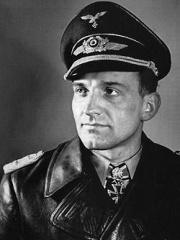
5. Hans-Ulrich Rudel (1916 - 1982)
With an HPI of 75.65, Hans-Ulrich Rudel is the 5th most famous Polish Military Personnel. His biography has been translated into 45 different languages.
Hans-Ulrich Rudel (2 July 1916 – 18 December 1982) was a German ground-attack pilot during World War II and a post-war neo-Nazi activist. The most decorated German pilot of the war and the only recipient of the Knight's Cross with Golden Oak Leaves, Swords, and Diamonds, Rudel knocked out 519 tanks, one battleship, one cruiser, 70 landing craft and 150 artillery emplacements. He claimed nine aerial victories and the destruction of more than 800 vehicles. He flew 2,530 ground-attack missions exclusively on the Eastern Front, usually flying the Junkers Ju 87 "Stuka" dive bomber. Rudel surrendered to US forces in 1945 and emigrated to Argentina. An unrepentant Nazi, he helped fugitives escape to Latin America and the Middle East, and sheltered Josef Mengele, the former SS doctor at Auschwitz. He worked as an arms dealer to several right-wing regimes in South America, for which he was placed under observation by the US Central Intelligence Agency. In the West German federal election of 1953, Rudel was the top candidate for the far-right German Reich Party but was not elected. After the 1955 military coup d'etat that deposed constitutional president Juan Perón, Rudel moved to Paraguay, where he acted as a foreign representative for several German companies.

6. Konstantin Rokossovsky (1896 - 1968)
With an HPI of 74.73, Konstantin Rokossovsky is the 6th most famous Polish Military Personnel. His biography has been translated into 59 different languages.
Konstantin Konstantinovich Rokossovsky (9 December [O.S. 21 December] 1896 – 3 August 1968) was a Soviet and Polish general who served as a top commander in the Red Army during World War II and achieved the ranks of Marshal of the Soviet Union and Marshal of Poland. He also served as Defence Minister of Poland from 1949 to 1956. Rokossovsky was born to a Polish noble family in Warsaw in present-day Poland, then part of the Russian Empire, or according to other sources in Velikiye Luki in present-day Russia. He served in the Imperial Russian Army during World War I, and in 1918, joined the Red Army and fought with distinction during the Russian Civil War. Rokossovsky rose to hold senior Red Army commands by 1937, when he fell victim to Joseph Stalin's Great Purge and was branded a traitor, imprisoned and tortured. After Soviet failures in the Winter War, Rokossovsky was released from prison in 1940 and returned to command of an army corps. Following Germany's invasion of the Soviet Union in June 1941, Rokossovsky played key roles in the Battle of Smolensk and defense of Moscow, where he led the 16th Army to victory. He was commander of the front that defeated the Axis at the Battle of Stalingrad in early 1943, and that summer played a vital role in the Battle of Kursk. In 1944, Rokossovsky was instrumental in planning and executing parts of Operation Bagration, and was promoted to Marshal of the Soviet Union that June. His 1st Belorussian Front reached the outskirts of Warsaw by July 1944, when its command was transferred to Georgy Zhukov. Rokossovsky commanded the 2nd Belorussian Front during the Vistula–Oder Offensive into Germany and final victory. After the war, Rokossovsky was the commander of the Soviet forces in Poland from 1945 to 1949, when he was given the title of Marshal of Poland and became the Defence Minister of the newly-established Polish People's Republic. He also served as deputy chairman of its Council of Ministers from 1952 to 1954. After being forced out of his post in 1956 when Władysław Gomułka became leader during the Polish October, Rokossovsky returned to the Soviet Union, where he lived out the rest of his life until his death in 1968.

7. Werner von Blomberg (1878 - 1946)
With an HPI of 74.01, Werner von Blomberg is the 7th most famous Polish Military Personnel. His biography has been translated into 40 different languages.
Werner Eduard Fritz von Blomberg (2 September 1878 – 13 March 1946) was a German field marshal and politician who served as the first Minister of War in Nazi Germany from 1933 to 1938. Blomberg had served as Chief of the Truppenamt, equivalent to the German General Staff, during the Weimar Republic from 1927 to 1929. Blomberg served on the Western Front during World War I and rose through the ranks of the Reichswehr until he was appointed chief of the Truppenamt. Despite being dismissed from the Truppenamt, he was later appointed Defence Minister by President Paul von Hindenburg in January 1933. Following the Nazis' rise to power in Germany, Blomberg was named Minister of War and Commander-in-Chief of the German Armed Forces. In this capacity, he played a central role in Germany's rearmament as well as purging the military of dissidents to the new regime. However, as Blomberg grew increasingly critical of the Nazis' foreign policy, he was ultimately forced to resign in the Blomberg-Fritsch affair in 1938 orchestrated by his political rivals, Hermann Göring and Heinrich Himmler. Thereafter, Blomberg spent World War II in obscurity until he served as a witness in the Nuremberg trials shortly before his death.

8. Erwin von Witzleben (1881 - 1944)
With an HPI of 73.76, Erwin von Witzleben is the 8th most famous Polish Military Personnel. His biography has been translated into 40 different languages.
Job Wilhelm Georg Erwin Erdmann von Witzleben (4 December 1881 – 8 August 1944) was a German Generalfeldmarschall (Field Marshal) in the Wehrmacht and Oberbefehlshaber West (Commander in Chief in the West), during the Second World War. A leading conspirator in the 20 July plot to assassinate Adolf Hitler, he was designated to become Commander-in-Chief of the Wehrmacht in a post-Nazi regime, had the plot succeeded. After being dishonourably discharged by the Ehrenhof (Court of Honor), he was murdered, after a show trial from the Volksgerichtshof (People's Court).

9. Erich von Falkenhayn (1861 - 1922)
With an HPI of 73.67, Erich von Falkenhayn is the 9th most famous Polish Military Personnel. His biography has been translated into 46 different languages.
Erich Georg Sebastian Anton von Falkenhayn (11 September 1861 – 8 April 1922) was a German general and Ottoman Field Marshal who served as Prussian Minister of War and Chief of the German General Staff during the First World War. Falkenhayn replaced General Helmuth von Moltke the Younger in September 1914 after his invasion of France was stopped at the First Battle of the Marne and was in turn removed on 29 August 1916 after the failure of his offensive strategy in the west at the Battle of Verdun, the opening of the Battle of the Somme, the Brusilov Offensive and the Romanian entry into the war. Having planned to win the war before 1917, the German army was reduced to hanging on. Falkenhayn was given important field commands in Romania and Syria. As a commander in the Middle East, he prevented a planned Ottoman deportation of Jews from Palestine. His reputation as a war leader was attacked in Germany during and after the war, especially by the faction supporting Field Marshal Paul von Hindenburg. Falkenhayn held the belief that Germany could not win the war by a decisive battle but would have to reach a compromise peace; his enemies said he lacked the resolve necessary to win a decisive victory. Falkenhayn's relations with the Chancellor Theobald von Bethmann Hollweg were troubled and undercut Falkenhayn's plans.
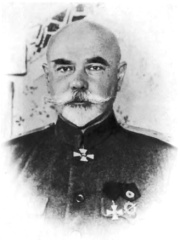
10. Anton Denikin (1872 - 1947)
With an HPI of 72.88, Anton Denikin is the 10th most famous Polish Military Personnel. His biography has been translated into 53 different languages.
Anton Ivanovich Denikin (Russian: Анто́н Ива́нович Дени́кин; 16 December [O.S. 4 December] 1872 – 7 August 1947) was a Russian military leader who served as a lieutenant general in the Imperial Russian Army and as a leading general of the anti-Bolshevik White movement during the Russian Civil War. A veteran of the Russo-Japanese War and a highly decorated commander in World War I, Denikin rose to prominence for his leadership of the "Iron Brigade". Following the February Revolution, he became a vocal critic of the Russian Provisional Government's military policies. After the October Revolution, he was a co-founder of the anti-Bolshevik Volunteer Army in South Russia. He assumed command of the army in April 1918 and became the Commander-in-Chief of the Armed Forces of South Russia (AFSR) in January 1919. In mid-1919, Denikin's forces launched the Moscow offensive, a major assault that captured large swathes of territory and advanced to within 350 kilometres (220 miles) of the capital, representing the high-water mark of the White movement. However, the offensive was ultimately defeated by a Red Army counter-attack. The defeat was attributed to several factors, including overstretched supply lines and the White movement's political failures. Denikin's government, the Special Council, failed to implement an effective land reform policy to win the support of the peasantry, while its uncompromising slogan of "a great, united, and indivisible Russia" alienated potential allies, including the Cossacks and various national minorities. The territories under Denikin's control were also ravaged by waves of brutal antisemitic pogroms, which he failed to suppress, discrediting the movement internationally and eroding its internal discipline. After a disastrous retreat, Denikin resigned his command to General Pyotr Wrangel in April 1920 and went into exile. He lived in France and, after World War II, in the United States. He dedicated his life in exile to writing, producing a multi-volume memoir, The Russian Turmoil, and other historical works. A staunch Russian patriot and an opponent of communism, Denikin urged Russian émigrés to support the Red Army in defending their homeland against Nazi Germany during World War II. He remains a controversial figure in Russian history, remembered for his military skill and personal courage, but criticized as an inflexible and politically inept leader whose defeat was a crucial factor in the Bolshevik victory. In 2005, his remains were reinterred in Moscow.
People
Pantheon has 81 people classified as Polish military personnels born between 1667 and 1951. Of these 81, none of them are still alive today. The most famous deceased Polish military personnels include Erich Ludendorff, Fedor von Bock, and Manfred von Richthofen.
Deceased Polish Military Personnels
Go to all RankingsErich Ludendorff
1865 - 1937
HPI: 77.47
Fedor von Bock
1880 - 1945
HPI: 77.17
Manfred von Richthofen
1892 - 1918
HPI: 76.98
Günther von Kluge
1882 - 1944
HPI: 76.30
Hans-Ulrich Rudel
1916 - 1982
HPI: 75.65
Konstantin Rokossovsky
1896 - 1968
HPI: 74.73
Werner von Blomberg
1878 - 1946
HPI: 74.01
Erwin von Witzleben
1881 - 1944
HPI: 73.76
Erich von Falkenhayn
1861 - 1922
HPI: 73.67
Anton Denikin
1872 - 1947
HPI: 72.88
Władysław Sikorski
1881 - 1943
HPI: 71.72
Alfred von Tirpitz
1849 - 1930
HPI: 71.66
Overlapping Lives
Which Military Personnels were alive at the same time? This visualization shows the lifespans of the 25 most globally memorable Military Personnels since 1700.

